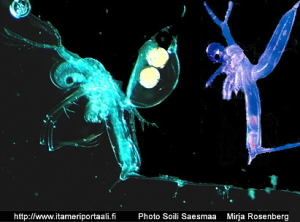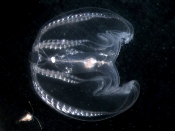Alien species
An increasing threat

Due to increasing shipping, more alien species are finding their way into the Baltic Sea than ever before (Fig. 1). These non-indigenous invaders can induce considerable changes in the structure and dynamics of marine ecosystems. They may also hamper the economic use of the sea or even represent a risk to human health. Over 120 non-native aquatic species have been recorded in the Baltic Sea to date, and around 80 of these have established viably reproducing populations in some parts of the Baltic. Most of these invasive species originate from freshwater or brackish-water environments, particularly from North America or the Ponto-Caspian region.
In some cases, alien species have been deliberately introduced for fishing or aquaculture, but most have been brought in accidentally by ships, which can rapidly transport marine animals, plants and algae across the world in their bilge and ballast waters.
Non-native species can seriously disrupt ecosystems, and harm livelihoods. Fishermen in the Gulf of Riga and the Gulf of Finland remember the sudden arrival in 1992 of an alien water flea species. These tiny animals soon started to clog up the gills of fish and fishing nets, leading to serious economic losses. By 1998 the species had spread as far as Stockholm and Gotland.
In the southern Baltic Sea non-native species have altered local ecosystems repeatedly. Species of Ponto-Caspian origin have dispersed through central Europe via man made channels, while other species have hitchhiked in ship ballast waters. Many of the species have become established in polluted areas, where living-conditions have driven native species to their tolerance limit. Invaders with higher pollution tolerance have replaced or outnumbered native species and even these have been replaced by more recent newcomers. The native fauna and flora of the Baltic Sea would better resist invaders in good water quality, which puts further emphasis on the need to protect our sea area.
Four invaders

Cercopagis pengoi is a predatory water flea which is native to the Ponto-Caspian region, the Caspian Sea, the Aral Sea and the Azov Sea. It was first observed in the Gulf of Riga and the Gulf of Finland in 1992, and in 1995 it was found in large quantities in samples from the eastern Gulf of Finland. This species clogs fishing nets and competes with herring for zooplankton prey. It was exceptionally numerous in the Bothnian Bay during the warm summer of 2002.

Marenzelleria viridis is a polychaete worm that lives inside bottom sediments. It was observed in the southern Baltic Sea for the first time in 1985, but has subsequently spread all the way up to the Bothnian Bay. Its distribution has mainly been restricted to shallow coastal areas, but in 2000–2002 Marenzelleria started to colonize the deeper waters of the Bothnian and Åland Seas, and soon established into the Bothnian Bay. Marenzelleria can out-compete the very few species that form the native benthic community in the northern Baltic Sea and thus alter the structure of the whole benthic ecosystem.

Prorocentrum minimum is a phytoplankton species of the open seas. It may originally have been brought into the Baltic Sea by currents or in ships’ ballast water. It is well established as a common species in the southern Baltic Sea, but in summer 2002 it formed blooms also in the Archipelago Sea along the Finnish coast, and it has also been found in the Gulf of Finland. There are no records of toxic Prorocentrum blooms in the Baltic Sea.

The American comb jelly Mnemiopsis leidyi is a gelatinous pelagic ctenophore, which feeds on zooplankton and juvenile fish. It was first found in the southern Baltic Sea in the autumn of 2006, and already in the summer of 2007 it thrived in the northern parts of the Baltic Sea basin. In the Black Sea, the species has created an environmental and economical catastrophe by depleting populations of commercially important fish species and changing the whole food web structure of the sea. The American comb jelly tolerates salinities down to 3 psu and temperature down to 4˚C and does not have natural enemies in the Baltic Sea.
HELCOM Actions
The HELCOM countries have agreed to ratify by 2010, or at the latest by 2013, the 2004 International Convention on the Control and Management of Ships’ Ballast Water and Sediments (BWM Convention). The entry into force of the BWM Convention would be a crucial step towards the reduction of spreading of non-indigenous species regionally and worldwide. To facilitate ratification, the HELCOM Ballast Water Road Map was adopted as a part of the HELCOM Baltic Sea Action Plan.
As part of this process HELCOM countries joined the OSPAR initiative which requests vessels transiting the Atlantic or entering the North-East Atlantic from routes passing the West African Coast to conduct on a voluntary basis ballast water exchange before arriving at the OSPAR area or passing through the OSPAR area and heading to the Baltic Sea. The joint OSPAR/HELCOM General Guidance on the Voluntary Interim application of the D1 Ballast Water Exchange Standard in the North-East Atlantic have been applied from 1 April 2008 as informed in the IMO circular BWM.2/Circ.14.
A similar initiative to address vessels leaving the Baltic and transiting through the OSPAR maritime area to other destinations has been undertaken, whereby as of 1 January 2010 ballast water will not be exchanged in the Baltic or until the vessel is 200 nm off the coast of North West Europe and in waters deeper than 200 m (The HELCOM/OSPAR General Guidance on the Voluntary Interim Application of the D1 Ballast Water Exchange Standard by vessels leaving the Baltic Sea and transiting through the North-East Atlantic to other destinations).
To promote the voluntary ballast water exchange according to the Guidance, Baltic Sea countries are recommended to conduct information campaigns, including Joint Notice to Shipping, and issue a letter of compliance for ships that have adhered to the Guidance.
Additionally, to prepare for implementation of the Ballast Water Management Convention a list of non-indigenous, cryptogenic and harmful native species in the Baltic Sea as well as a list of Target species that may impair or damage the environment, human health, property or resources in the Baltic Sea have been developed. More information about the lists can be found here.
Links
Marine alien species of Estonia
Database on Alien Species in the Baltic Sea
Risk Assessment of Ballast Water Mediated Species Introductions - a Baltic Sea Approach, 2006

